#bowden neve
Text
Basler to the Beardmore 2: Errands
As always, no matter what Tumblr does with it, this post is available in its intended presentation at twirlynoodle.com/blog along with the rest of my Antarctic travel diary.
On this flight to the heart of Antarctica, I was only a hanger-on. We had two errands to run before entertaining me and my historical interests, the most important of which was restocking a fuel depot at the base of the Transantarctic Mountains.
There are many busy science teams in Antarctica, and while some renewable energy sources are starting to be used, the fact is that everything runs on a reliable supply of fossil fuels, mostly petrol. The aircraft that keep people and their essentials moving around the continent have a network of fuel depots, both for relay stops and for emergencies. Contrary to some conspiracy theories, anyone can fly to and around Antarctica if they have the money and resources to get there, and many do. As the national science programmes have a very tight margin, and their fuel depots are expensive to maintain, they cannot afford jet-setters raiding their supplies, so the locations of these depots are kept secret. Therefore I am not going to tell you where our first stop was. The chances of a private pilot reading this blog are slim, but it may be possible to deduce from my photos where this particular cache is: if you are that outlier, I hereby ask you please to do the decent thing and leave the fuel alone – or if you absolutely must access it, then let the USAP know what you've taken and make good on it as soon as you can. Everyone in Antarctica looks out for each other, and that includes you. OK? OK.
So, we've taken off, and done our acrobatics to get the skis up, and are now facing a couple of hours' flight time before we reach our primary destination. There is, quite frankly, nothing between Williams Field and the Transantarctic Mountains, besides hundreds of miles of the Ross Ice Shelf. This was known as 'The Barrier' to the early explorers, because when James Clark Ross sailed down to explore in 1840 it was a great while wall that prevented his ships from going any further. In later years it wasn't so much a barrier as a highway – clear and flat, and not much off sea level, it provided a route deep into the high latitudes without the perils of the high windy Polar Plateau. Among people who frequently travel out there, it is sometimes referred to as 'the Flat White' – my impression is that this term came from the Kiwis, and the espresso drink of the same name is also antipodean in origin, so I wonder which came first. It is undeniably Flat, and White (though the refraction of sunlight through ice crystals makes it look anything from peachy to periwinkle, depending on the angle), but none of its various names communicate just how big it is.
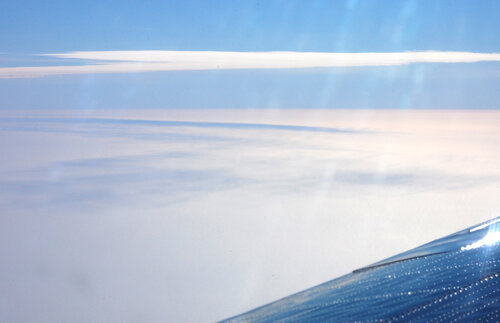
I have flown over the Canadian tundra many times, and over the Greenland ice cap, but the view from 35,000 feet is like looking at satellite view in Google Maps compared to flying at cloud level, where the parallax with the horizon gives you a much keener sense of distance. The Barrier is BIG. In fact, 'big' is too small a word to communicate it. 'Massive', 'mammoth', and 'gargantuan' are more melodramatic than descriptive. Its vastness puts all of human consciousness, never mind vocabulary, in proper perspective. For my money, it outdoes the night sky as a visual approximation of infinity.
Getting a sense of its size, especially in a still photo, is difficult without an object for scale. For your education and my good fortune, we happened to fly over the RAID convoy as they made their way from the Minna Bluff site to where the Ross Ice Shelf meets the Antarctic continent. Rapid Access Ice Drilling has been supporting various scientific projects for a few years now, whether their interest is in the ice itself (its trapped air gives a record of Earth's atmosphere in millennia past) or what's underneath (marine environments far removed from the open sea; the bed of an accelerating glacier). Their units are about the size of a shipping container, and are pulled by enormous tractors, so if they are this dwarfed by the Flat White, imagine how much more puny a sledge party would be.
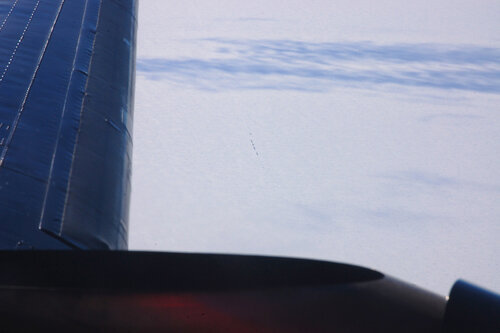
Before too much longer we were at the depot. Landing at an Antarctic field airstrip is even more complicated than taking off: we circled once, to do a visual check, then skimmed it with the skis to make sure no hidden crevasses had opened up since the last time someone landed here, then finally touched down for real on the third go-round. The plane crew rapidly got to work unloading the fuel drums; I offered to help but was assured I wasn't needed, so spent the time taking photographs and mucking around in the snow.



The first thing that struck me was how beautiful the mountains were in colour. The best photos I've seen of them have been black and white, so the rich variety in shades was remarkable. What you can't see in this small photo was how the lighter rock was banded with strata of blue-grey and orange-brown sandstone, giving it a luxurious marbled effect.
I've read a lot about how conditions on the Barrier are so much different than on the coast. This was far deeper into it than I was ever expecting to set foot, but I was surprised how tame it was. Now, it was an idyllically calm and sunny day – had it been any different we would not have been there – so the only time I realised that it was actually much colder than McMurdo was when a slight breeze wafted past my bare hand and broke the warm spell that the sunshine had cast.
What was different was the snow. Around McMurdo, the snowbanks which did build up had been repeatedly blown over with volcanic dust which warmed up in the sun and made the snow gritty, icy, and rotten – if you live in a snowy city, think of the texture of snowbanks alongside busy roads. Out here, there was nothing but snow, all the way down to where it became ice – powder blown off the mountains, maybe even off the Polar Plateau, deposited here to be compacted in the sun and polished by the wind. The crust made by these processes was smooth and, in many places, thick enough to support my weight, so I hardly left a footprint – a 'good pulling surface' as sledgers would have it – but without warning there would be a thin spot where my foot would break through and sink in the sugar-like snow below.
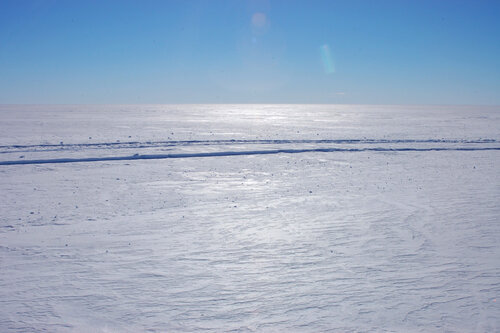
Before long, the crew had finished their restock, and playtime was over. After our exciting takeoff manoeuvres, we started climbing the mountains to the second of our tasks for the day.
The Transantarctic Mountains, according to our pilot, are still something of a mystery. They are a very high mountain range, but unlike the Rockies for example, they show little or no sign of buckling or other geological forces – they seem to have been lifted whole, keeping their layers of sandstone and coal and fossil-rich deposits mostly flat, with occasional intrusions of igneous rock. The range acts as a sort of massively oversized dyke, holding back the miles-deep polar ice cap from spilling over West Antarctica, the Ross Ice Shelf, and the Ross Sea, as the mountains cross the continent.
Ice appears to be solid, but it actually behaves more like a stiff jelly or fondant icing – if it finds a change in altitude it will flow, very slowly, downhill. This is what a glacier is: snow gets deposited over many years without melting, turns to ice, and when its volume can no longer be held at elevation, starts to creep down the valley. The ice of the Polar Plateau finds gaps in the Transantarctic Mountains and pushes through them, forming glaciers which pour out onto the Ross Sea and, merging, form the Ross Ice Shelf. The Beardmore Glacier is one of the largest of these, but there are hundreds of smaller ones, and many tributary glaciers that feed these. In flying over the lower Transantarctic Mountains, there were plenty of opportunities to see ice dynamics at work:
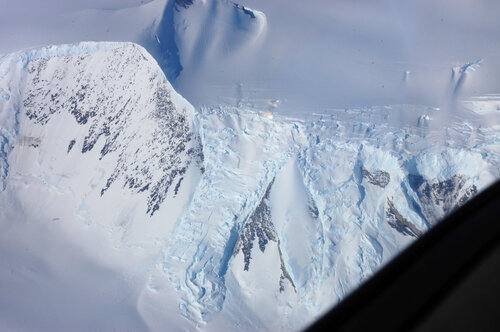
Our destination was up near the head of a narrow glacier, where it broadened out into a snowy plain called the Bowden Névé – névé being a term for young snow which has not yet compacted into glacial ice but is in a position to do so. This was CTAM (pronounced see-tam), a geology camp established to be a hub for teams doing work in the Central TransAntarctic Mountains. The névé afforded an open, soft, flat place to land planes carrying supplies and people, who could then move on to less accessible places overland. At least, it did, until a wind event a few years ago scoured deep furrows in the landing strip.
As we flew over, doing the visual check, I was astonished the site could be spotted at all, as it was only a small clutch of bamboo poles in the vast expanse.

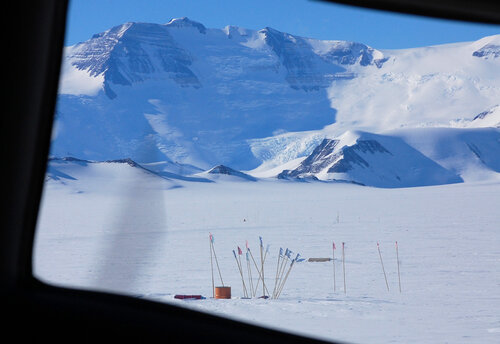
Having proven that the landing strip was landable, the next task was to see what condition the building was in. What building, you ask? Why, the one completely covered in snow, under the markers. Once upon a time it was a couple of modules standing on the surface of the glacier, but Antarctica gradually swallowed them up, so now one has to dig down through the snow to reach the roof hatch, eight feet above the floor.
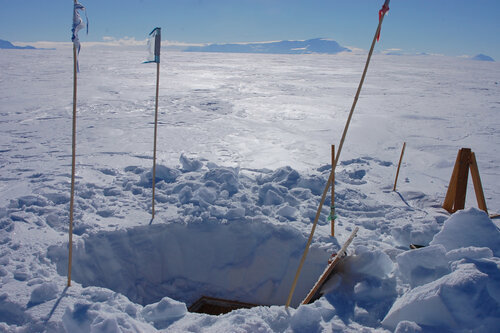
On the way from the Basler to the camp site, I was treated to one signature snow effect I had missed out on, at the depot. 'The Barrier Hush' is frequently mentioned in journals: it was described as a 'whoosh' or a 'hush-shh-shhhh' that sighed out from underneath the walker as he broke through the top crust into a pocket of air underneath, where the loose snow had settled after the top crust was formed. The pocket could sometimes extend quite a long way from where the crust was broken and the sound followed the exchange of air as far as it went. It would startle the ponies and excite the dogs, until they learned there was nothing to chase and catch.
I was walking some way behind the plane crew as they made for the camp with shovels, and suddenly heard what I thought was a small whirlwind – a sharp and intense, almost whistling sound that seemed to race across my path. This being the sort of place one would expect to see dust devils (or snow devils, I suppose they would be) I looked around to see where it was, but the air was as still up here as it had been down on the ice shelf. It was only after the second or third time it happened that I realised what it was – it was so completely not how I had imagined the Barrier Hush to sound. If you make a little whirlwind sound by whisper-whistling whshwshywshwhwwsh with your lips really quickly, that's what it sounded like. Having heard it, now, I can completely understand how the dogs would have thought there was a small creature scurrying around under the snow. It sounded much more animate than it had been described. I felt so lucky to be let into that secret.
The crew got the hatch open and the first of them climbed down into the pitch darkness to report everything OK. The rest followed, and invited me along, but I am not the most coordinated travelling artist, and couldn't see a way down for me that didn't end in a concussion. So I stayed above while they explored the submerged camp, and enjoyed the view. It was really spectacular – not just the stunning mountains but the thin, brittle blue of the sky and the hardness of the sunlight, as if the whole world were a taut drumskin.
And, best of all, from here the horizon was the Polar Plateau – another Flat White stretching to the South Pole and beyond.
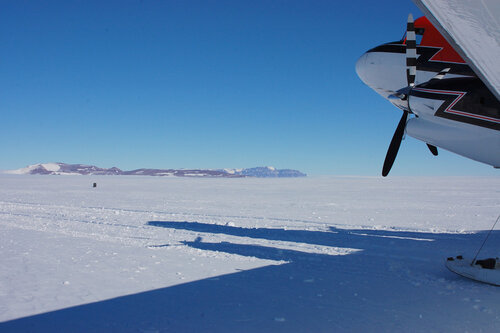
#antarctica#travel#basler#dc3#CTAM#air freight#mountains#transantarctic mountains#bowden neve#geology#field camp#photos
58 notes
·
View notes
Text
hosszú, felvágós poszt
mert egyszer egy évben én is megengedem magamnak, hogy dicsekedjek valamivel :”D
szóval imé a 2019-es könyvlistám, amiket *mind* el is olvastam, elejüktől a végükig~
ja és előbb még külön köszönet @jodontesajodontesnek a remek ajánlásokért és @galacticbunblrnek a cosmic discipline-ért :3 ennyire képes napi átlag 80 perc olvasás :D
darabra 40, órára 482 (lassan olvasok :v), oldalra kb 14.500 (a 30 oldal/óra átlag sebességemmel számolva)
Patrick Rothfuss - A szél neve
Patrick Rothfuss - A bölcs ember félelme
Neil Gaiman - American Gods
Neil Gaiman - Good Omens
Neil Gaiman - Anansi Boys
H. P. Lovecraft - Onnan túlról [Helikon féle novelláskötet]
Dan Brown - Eredet
Raana Raas - Csodaidők 1 - Az ogfák vöröse
Raana Raas - Csodaidők 2 - Kiszakadtak
Raana Raas - Csodaidők 3 - Árulás
Raana Raas - Csodaidők 4 - Hazatérők
Andy Weir - The Martian
Andy Weir - Artemis
Oliver Bowden - Assassin’s Creed - The Secret Crusade
Oliver Bowden - Assassin’s Creed - Revelations
Oliver Bowden - Assassin’s Creed - Forsaken
Oliver Bowden - Assassin’s Creed - Black Flag
Oliver Bowden - Assassin’s Creed - Unity
Orvos-Tóth Noémi - Örökölt sors
Susan David - Érzelmi rugalmasság
Susan Forward - Mérgező szülők
Alexandre Dumas - A három testőr
Agatha Christie - And Then There Were None
Naomi Alderman - The Power
Jorge Semprún - A nagy utazás
John Steinbeck - The Moon Is Down
Niccolò Machiavelli - A fejedelem
Marcus Aurelius - Elmélkedések
Terry Pratchett - Discworld 1 - The Colour of Magic
Terry Pratchett - Discworld 2 - The Light Fantastic
Terry Pratchett - Discworld 3 - Equal Rites
Terry Pratchett - Discworld 4 - Mort
Terry Pratchett - Discworld 5 - Sourcery
Terry Pratchett - Discworld 6 - Wyrd Sisters
Terry Pratchett - Discworld 7 - Pyramids
Terry Pratchett - Discworld 8 - Guards! Guards!
Terry Pratchett - Discworld 9 - Eric
Terry Pratchett - Discworld 10 - Moving Pictures
Terry Pratchett - Discworld 11 - Reaper Man
Terry Pratchett - Discworld 12 - Witches Abroad
16 notes
·
View notes
Note
GUYS!! :D are you able to recommend me any faceclaims with white hair aside from emilia clarke? Any ethnicity. Thank you!
Carmen Dell'Orefice (1931)
Yazemeenah Rossi (1955)
Fan Bingbing (1961) Chinese - The White Haired Witch Of Lunar Kingdom (2014)
Halle Berry (1966) African-American / English, German, Irish, distant Dutch - X-Men (2000 and 2003)
Kelly Hu (1968) English, Chinese, Hawaiian - Arrow (2012-2017)
Li Bingbing (1973) Chinese - The Forbidden Kingdom (2008)
Jaime Murray (1976) - Defiance (2013-2015)
Anne Hathaway (1982) - Alice in Wonderland (2010)
Beau Garrett (1982) - Tron: Legacy (2010)
Emily Blunt (1983) - Huntsman Winter’s War (2016)
Ivy Levan (1987) Cherokee.
Allison Harvard (1988)
Anna Akana (1989) Japanese, Native Hawaiian, possibly English, Irish, German, French, Chinese / Filipino, possibly Spanish.
Sasha Luss (1992)
Kim Nari (1992) Korean.
Shin Yoon-jo (1992) Korean.
Anna Ewers (1993)
La Thanh Thanh (1993) Vietnamese.
Samantha Ravndahl (1993)
Lookgade Chadaporn (1994?) Thai.
Silverrr (?)
Neve Caffrey (?)
Platinum / light blonde:
Kristen McMenamy (1964)
Elizabeth Banks (1974)
Shiina Ringo (1978) Japanese.
Kate Hudson (1979)
Hannah Spearritt (1981)
Miranda Lambert (1983)
Caridee English (1984)
Marina Diamandis (1985)
Park Soo-Joo (1986) Korean.
Hannah Hart (1986) Ashkenazi Jewish / English, possibly other - lesbian.
Poppy Delevingne (1986)
Kim Boa (1987) Korean.
Song Haena (1987) Korean.
Jorgie Porter (1987)
Katrina Bowden (1988)
Portia Doubleday (1988)
Zoe Kravitz (1988) African-American, Afro-Bahamian / Ashkenazi Jewish.
Bryden Jenkins (1991)
Evanna Lynch (1991)
Val Mercado (1992) Moroccan.
Sky Ferreira (1992) Brazilian [Portuguese, possibly other] / Ashkenazi Jewish, Native American [Cheyenne, possibly Chippewa (Ojibwe) and Chippewa-Cree], Scottish, French, English, and Irish.
Alena Shishkova (1992)
Jess Plummer (1992) Afro Jamaican, English.
Hanli Hoefer (1992) Peranakan Chinese / White.
Eugénie Grey (1993) Korean.
Saweetie (1993) Black / Filipino.
Witney Carson (1993)
Jazzelle (1993) Black, other.
Raiden Quinn (1994) - trans.
Amelia Lily (1994)
Julia Garner (1994)
Kali Uchis (1994) Colombian.
Mia Stammer (1994) Japanese / White.
Eden Estrada (1995) Mexican - trans.
Herieth Paul (1995) Tanzanian.
Aurora (1996)
Astrid Smeplass (1996)
Turnbull Ayumi (1996) Japanese / White.
Elena Kampouris (1997)
Amanda Arcuri (1997) Argentinian, Italian.
India Makailah Graham (1998) Black, possibly other.
Tserendolgor Battsengel (?) Mongolian.
Yana Shmaylova (?) Korean, Russian.
Britni Sumida (?) Japanese, White.
Dominique Babineaux (?) Black.
Victoria Brito (?) Afro-Brazilian, European.
-C
24 notes
·
View notes
Text
Bicameral
PAUL MCCARTNEY'S GARBLED THIGH
JON GOSSELIN'S GARBLED THIGH
MICHAEL BOLTON'S GARBLED THIGH
QUENTIN TARANTINO'S GARBLED THIGH
MELISSA RYCROFT'S GARBLED THIGH
MATTHEW PERRY'S GARBLED THIGH
KATRINA BOWDEN'S GARBLED THIGH
MAKSIM CHMERKOVSKIY'S GARBLED THIGH
RYAN PHILLIPPE'S GARBLED THIGH
UMA THURMAN'S GARBLED THIGH
MARC ANTHONY'S GARBLED THIGH
WILMER VALDERRAMA'S GARBLED THIGH
DONALD FAISON'S GARBLED THIGH
SALMAN KHAN'S GARBLED THIGH
AARON ECKHART'S GARBLED THIGH
WIZ KHALIFA'S GARBLED THIGH
MATT LANTER'S GARBLED THIGH
STEPHEN MOYER'S GARBLED THIGH
DAVE NAVARRO'S GARBLED THIGH
MICHAEL BUBLÉ'S GARBLED THIGH
KATIE HOLMES'S GARBLED THIGH
JENNIFER LAWRENCE'S GARBLED THIGH
JAMIE KENNEDY'S GARBLED THIGH
SEAL'S GARBLED THIGH
AUDRINA PATRIDGE'S GARBLED THIGH
BARACK OBAMA'S GARBLED THIGH
JOSH DUHAMEL'S GARBLED THIGH
MATT DILLON'S GARBLED THIGH
SCOTT SPEEDMAN'S GARBLED THIGH
ALEX O'LOUGHLIN'S GARBLED THIGH
HOWARD STERN'S GARBLED THIGH
NEVE CAMPBELL'S GARBLED THIGH
CHER'S GARBLED THIGH
KIM KARDASHIAN'S GARBLED THIGH
JILLIAN MICHAELS'S GARBLED THIGH
TAYLOR SWIFT'S GARBLED THIGH
LADY GAGA'S GARBLED THIGH
JAY Z'S GARBLED THIGH
DIANNA AGRON'S GARBLED THIGH
CHRIS EVANS'S GARBLED THIGH
JERRY SEINFELD'S GARBLED THIGH
JOSH HARTNETT'S GARBLED THIGH
SARAH PALIN'S GARBLED THIGH
MELISSA GORGA'S GARBLED THIGH
MARK WAHLBERG'S GARBLED THIGH
SOPHIA BUSH'S GARBLED THIGH
NAOMI CAMPBELL'S GARBLED THIGH
DWAYNE JOHNSON'S GARBLED THIGH
TAMRON HALL'S GARBLED THIGH
ASHLEY GREENE'S GARBLED THIGH
0 notes
Text
Why “Wild Things” Was A Defining Film For Gay Men In The ’90s
https://styleveryday.com/2018/03/20/why-wild-things-was-a-defining-film-for-gay-men-in-the-90s/
Why “Wild Things” Was A Defining Film For Gay Men In The ’90s
Columbia Pictures
For gay men who grew up in the ’90s, there are two distinctive eras: the time before we saw Kevin Bacon’s full-frontal scene in Wild Things, and the time after.
It’s been 20 years to the day since Wild Things hit theaters. This was two decades before Moonlight, before Love, Simon, before Call Me by Your Name: LGBT representation certainly existed, in indie comedies (1995’s Jeffrey) or the occasional prestige AIDS drama (1993’s Philadelphia), but it was neither plentiful nor especially mainstream. Many of us who were still figuring ourselves out gravitated less toward more overt depictions of gayness, like The Birdcage or In & Out, and more to subtler, subtextually homoerotic representation.
It feels absurd to use the word “subtle” in connection to Wild Things, the kind of steamy erotic thriller that should have been relegated to late-night Cinemax but somehow ended up with a wide release. It is too deliberately over-the-top to be regarded as true camp, although that doesn’t make it any less fun. But whether intentionally or not, there is an undercurrent of gayness that made it especially titillating to all the curious and questioning teens who managed to bypass Blockbuster’s age-restricted rental prohibitions. On paper, it’s a movie that feels designed for straight bros, but in reality, it proved much more appealing to closet queers.
That’s part of what made it such an attractive option: Wild Things was the slightly more respectable version of watching the Pamela Anderson–Tommy Lee sex tape and keeping your eyes focused entirely on Tommy Lee. The only overt same-sex content in the movie is the steamy pool scene between Neve Campbell’s Suzie Toller and Denise Richards’ Kelly Van Ryan, and the threesome involving the two and Matt Dillon as lecherous teacher Sam Lombardo. These aren’t moments of genuine passion between two women so much as a shameless excuse to pander to straight male viewers eager to see two girls making out. And yet, despite the male-gaziness of those sapphic scenes, there is a distinct feeling of true queerness, a wink to those watching Wild Things not for topless Denise Richards but for shirtless Matt Dillon.
Kelly (Denise Richards), Suzie (Neve Campbell), and Sam (Matt Dillon) have a threesome in Wild Things.
Columbia Pictures
Explaining the plot of Wild Things is an exercise in futility: The film is too twisty and convoluted to merit a full synopsis. Suffice it to say, it involves an elaborate con by an ever-increasing cast of players with shifting allegiances — not only Suzie, Kelly, and Sam, but also (spoiler alert) sleazy lawyer Kenneth Bowden (Bill Murray) and corrupt sergeant Ray Duquette (Kevin Bacon). And the film has aged horribly: The inciting incident is a false rape accusation that was cringey at the time and is now even more unbearable. But we can acknowledge how deeply offensive a movie is and also how formative its climactic shower scene was to a certain subset of gay millennials.
Near the end of the movie, after Sam has double-crossed Suzie and Kelly, he returns to his beach bungalow to find someone in the shower. The figure emerging from the steam isn’t Suzie or Kelly, both presumed dead, but a fully nude Ray Duquette. It’s a pivotal moment that reveals both Ray’s complicity in Sam’s plot and, also, Bacon’s penis. Given the rarity of full-frontal male nudity on the big screen — particularly an A-list actor in a mainstream release — it’s a fairly shocking moment. But it also feels like much-needed confirmation to those who watched Wild Things suspecting there was something gay about it all along. The major twist is that a movie that seemed all about the male gaze is actually about the male gays.
Nudity aside, the scene is as homoerotic as it can be without Dillon and Bacon actually embracing. The men are clearly very comfortable with each other — there’s no hint of awkwardness when Sam walks in on Ray in the shower — and given the film’s relentless sexuality, the idea that these dudes might not just be friends and partners in crime feels more than a little implied. If Wild Things were made today — please, god, without the false rape accusation — it’s likely that the scene would have played out differently, with Sam joining Ray in the shower. (Or perhaps that’s just wishful thinking from a former closeted teen who always imagined it ending that way.)
It’s not surprising that Wild Things has emerged as a queer cult classic: It has all the elements of the genre. There’s Denise Richards, whose ’90s work also includes the quintessential Starship Troopers and Drop Dead Gorgeous. There’s the completely batshit plot, including a what-the-fuck incest twist delivered in some offhand exposition. And there’s the endlessly quotable dialogue, most of it coming from Richards: “Where’d she get the shoes, Whores for Less?” What is surprising is seeing, in retrospect, how much of that queerness might have been intentional from the beginning. It would be silly to suggest that Wild Things was a movie made for gay men — but it would be equally naive to dismiss its queer appeal as mere accident.
Thankfully, in the 20 years since Wild Things, we’ve seen major steps forward for actual LGBT representation — including love scenes between women that aren’t clearly designed to excite straight guys. But as retrograde and objectionable as the movie is in many ways, it’s still a fascinating relic of the era. And for those of us who were drawn to it years before we fully understood why, it’s a major piece of nostalgia, a comforting reminder of how far we’ve come and of those early forbidden thrills.
1 note
·
View note
Link
Two/One (Feature)
They say that Vancouver never plays itself. But at least Whistler will be able to for the next few weeks as Two/One starts filming in the area. The movie explores the possibility that we are in one place while we’re awake, and a totally different place while we’re sleeping. In this case, those two places are Whistler, BC and Shanghai, China.
An Olympic-level ski jumper named Kaden is in Whistler while Khai is a businessman in Shanghai who’s obsessed with the new girl at his office. The two men are connected, despite having never met before and had no knowledge of the other’s existence. While Kaden is sleeping, Khai is awake, and vice versa. They live their individual lives without affecting each other, that is of course unless they happen to meet and have to figure out who is real and who is the dreamer.
Logan/Narcos star Boyd Holbrook is set as one of the leads for the movie; presumably as Kaden/Khai. Boyd just wrapped up a role in the upcoming Predator movie which filmed in the Vancouver area as well. According to the film’s IMDb page, local actress Anna Van Hooft is set to appear in the movie as well. Anna has several credits on Vancouver-based productions including Cedar Cove, The Marine 5, Fringe, Flash Gordon and the upcoming Crash Pad movie.
Two/One will continue filming in British Columbia until December 3rd before relocating to Shanghai for the balance of production.
Also Starting This Week
Deadly Class (TV Pilot)
Cast: Benedict Wong, Benjamin Wadsworth, Lana Condor, Maria Gabriela de Faria, Luke Tennie, Liam James, Michel Duval, Henry Rollins, Taylor Hickson, Siobhan Williams, Jack Gillett, Sean Depner and Ryan Robbins
Filming until December 5th.
For a full list of what’s filming in Vancouver and British Columbia right now, check out our In Production page.
Wrapping Up This Week
The Exorcist – Season 2 (TV Series) with Alfonso Herrera, Kurt Egyiawan, Ben Daniels, John Cho, Brianna Hildebrand, Zuleikha Robinson, Li Jun Li, Christopher Cousins and Cyrus Arnold wraps up November 14th
Courage to Soar: The Simone Biles Story (TV Movie) with Kathleen Perkins, Jeanté Godlock, Kelsey Scott, Julius Tennon and Tisha Campbell-Martin wraps up November 15th
Winter of Love (aka Extreme Love) (TV Movie) with Katrina Bowden, Thomas Beaudoin and Elysia Rotaru wraps up November 17th
Skyscraper (Feature) with Dwayne Johnson (The Rock), Neve Campbell, Pablo Schreiber, Noah Taylor and Chin Han wraps up November 17th
Morning Show Murders (TV Movie) with Holly Robinson Peete, David Lewis, Al Roker and Rick Fox wraps up November 18th
A Royal New Year’s Eve (TV Movie) with Jessy Schram and Sam Page wraps up November 18th
If you see any of these productions, including Two/One or Deadly Class filming in Vancouver and British Columbia, be sure to let us know by tweeting us (@WhatsFilming) or via our Submit a Location page.
The post Two/One: Whistler/Shanghai Set Movie With Boyd Holbrook Starts Filming appeared first on What's Filming?.
0 notes
Text
Az igazság még mindig odaát van
Továbbra sem tudjuk, ki állhatott John F. Kennedy amerikai elnök meggyilkolása mögött. Hiába ígérte meg Donald Trump, hogy nyilvánosságra hozza a gyilkossággal kapcsolatos összes aktát, eredményesen lobbiztak az ország biztonságára ügyelő szervezetek: elérték, hogy közel háromszáz dosszié továbbra is zárva maradjon a nyilvánosság előtt.
Az történt ezzel is, mint Trump korábbi nagy ígéreteivel, amelyekből eddig jórészt visszakozott. Mutatós jobboldali kormányzati csapattal állt elő, aztán szép csendben lecserélte az embereit. Most is megtréfálta a világsajtót, amikor azzal az ötlettel jött, hogy nem hosszabbítja meg az amerikai Nemzeti Levéltárban lévő Kennedy-akták titkosítását, azaz az összes dokumentum nyilvánosságra kerül. A felajzott újságírók alig várták a múlt csütörtököt, a világlapok külön csoportokat állítottak fel, hogy azonnal essenek neki a dokumentumok több tízezer oldalának. Aztán tudomásul kellett venniük, hogy nem kaptak meg mindent, különösen azt nem, amire vártak.
A Központi Hírszerző Ügynökség, a CIA főnöke, Mike Pompeo szinte az utolsó percekben győzte meg Trumpot arról, hogy a nemzetbiztonságra különösen veszélyes aktákat, mintegy háromszázat, ne oldja fel a titkosítás alól. Ezekben olyan, még ma is élő személyeket neveznek meg, akiknek élete veszélybe kerülhetne, ha kapcsolatuk a CIA-val kitudódna. Ezek a jelentések, amelyek még a ’90-es években is készülhettek, ráadásul olyan módszereket tárhatnak fel, amelyekkel az amerikai hírszerzők még ma is élnek.
Trump tehát elfogadta a CIA érvelését, de azzal a megkötéssel, hogy a visszatartott dokumentumokat fél éven belül meg kell vizsgálni, valóban nemzetbiztonsági kockázatot rejtenek-e. A legjobban várt iratok továbbra is titkosak, de nem állíthatjuk, hogy a közvélemény nem kapott semmit. A 2851 akta szenzációt nem tartalmaz, de megerősít bizonyos sejtéseket. Számos esetben „megszerkesztett” dokumentumokról van szó, amelyekbe bizonyára belenyúltak, vannak részek, amelyek nem folytatódnak, például nincs ott a válasz, hogy a merénylő CIA-ügynök
volt-e. Persze hátravan még a történészek munkája, akik nemcsak átfutják az oldalakat, hanem elmélyülnek bennük.
Az sem kizárt, hogy olyan összefüggésekre bukkannak, amelyek most elkerülték a figyelmet.
Maradjon a homály!
A fentieken kívül volt más oka is a CIA-nek és a FBI-nak, az amerikai Szövetségi Nyomozóirodának, hogy bizonyos aktákat továbbra is homály fedjen. Az elemzők szerint ezekből kiderülhet a két szervezet közti rivalizálás vagy éppen a hanyag munkavégzés, amelynek következményeképpen eldördülhettek az elnök életét kioltó dallasi lövések. De mielőtt a gyanús összefonódásokba belemegyünk, előbb idézzük fel az 54 évvel ezelőtt történteket! 1963. november 22-én 11 óra 40 perckor John F. Kennedy, az Egyesült Államok 35. elnöke megérkezett a dallasi reptérre. Felesége, Jacqueline is vele tartott. A látogatás célja, hogy az egy év múlva sorra kerülő elnökválasztást megelőző elnökjelölő kampányban az államfő találkozzon a texasi demokrata pártiakkal. Kennedynek a déli államban nem állt valami jól a szénája, 2500 vendég részvételével szerveztek ebédet, oda várták a híveiket. De előtte még tiszteletkört kellett tenniük Dallasban. A biztonsági szolgálat figyelmeztetése ellenére nyitott Lincolnt használtak, hogy közel kerüljenek az elnököt éltetőkhöz.
John F. Kennedy feleségével, valamint John Connallyvel, Texas kormányzójával és annak feleségével a merénylet előtti pillanatokban, 1963. november 22. Fotó: Reuters
Fél egykor az Elm Streetre szinte lépésben fordult be a jármű. Ekkor hat másodperc alatt legalább három lövés dördült el, egyes állítások szerint ennél több. Az első célt tévesztett, és megsebesített egy nézelődőt. A második a nyakán találta el államfőt. Ez az a „varázslatos golyó”, amely valami hihetetlen röppálya után a gépkocsi első ülésén helyet foglaló John Bowden Connally texasi kormányzóban folytatta az útját, keresztülhaladva a mellkasán, a kezén, végül a combjában állt meg. A harmadik, végzetes lövés fejen találta Kennedyt. Ekkor történt valami elképesztő: Jackie, a feleség kimászott a gépkocsi csomagtartójára, és kézzel próbálta összeszedni a férje felkenődött agymaradékát… A fekete Lincoln a legközelebbi, parklandi kórházba hajtott. Egy órakor az AP amerikai hírügynökség egyetlen szóval repítette a hírt világgá: halott.
„Ki nem ölte meg Kennedyt?” – ez volt a címe egy dokumentumfilmnek, amely az FBI által vizsgált 250 lehetséges elkövetőről szólt. Hivatalosan még mindig egy gyilkos van, ő Lee Harvey Oswald. Senki más neve nem fordult elő elkövetőként a most megnyitott aktákban, sem a merénylet után működő Warren-bizottság és még két hivatalos vizsgálat anyagaiban. Ebben azonban nem hisz az amerikai lakosság kétharmada. A gyilkosság időpontja környékén még a nyolcvan százalékot meghaladta azoknak a száma, akik elvetették, hogy egy „24 éves senki” egyedül kezet emeljen az Egyesült Államok egyik legnépszerűbb elnökére. Nagyobb erőt, jelentősebb szervezettséget gyanítottak a merénylet mögött. Egyharmaduk hisz abban, hogy a CIA vagy az FBI keze volt a dallasi gyilkosságban, ugyanennyien inkább a maffiára gyanakszanak.
A magányos merénylő hivatalos elmélete csupán a népesség 15-20 százalékát tudta maga mögé állítani.
Hoover aggódott Oswaldért
Erősen tartotta magát, hogy a szovjet KGB állt a merénylet mögött, amit a szakértők olyan ostobaságnak tartanak, mint azt, hogy ufók gyilkolták meg Kennedyt. Bár a szovjet szálat nem lehet kizárni, ha Oswald zavaros orosz kapcsolatára gondolunk. Vagy esetleg Fidel Castro megelégelte, hogy az Egyesült Államok az életére tör? Lyndon B. Johnson alelnökre is árnyék vetült, hiszen már az államfő holttestét Washingtonba szállító repülőgépen letette a hivatali esküt, ráadásul texasi lévén könnyen megszervezhette a merényletet. De Edgar Hoover FBI-vezető is gyűlölte a Kennedyeket, és tarthatott attól, hogy leváltják. Vagy talán a tábornokok csapatával megtámogatott hadiipari lobbi áll a háttérben, mert látta a korábban tomboló fegyverkezési verseny lanyhulását, és veszélyben érezte busás bevételeit? De gyanakodhatunk texasi szélsőséges elemekre is, akiknek elegük lett az elnök „elvakult polgári jogi tevékenységéből”.
Kennedynek élete 46 évében háromszor adták fel az utolsó kenetet Fotó: Reuters
Ennyi indítékot figyelembe véve kilátástalan vállalkozás megtalálni a tettest, ezért születtek a különböző összeesküvés-elméletek. Talán a most nyilvánosságra került tények által világosabb lesz a kép, de nem annyira, hogy tisztán lássunk.
Különösen érdekes Oswald kevesebb mint két hónappal a dallasi merénylet előtt tett hatnapos mexikói útja. Oswald a tengerészgyalogságnál szolgált lövészként, s egyes források szerint csapnivaló lövész volt, mások szerint meg kiváló. Amikor kitudódott marxista meggyőződése, kitették a hadseregből. Két évre a Szovjetunióba utazott, ott nősült meg, aztán a forradalmi Kubába indult, a kommunista sejtek munkájában vett részt. Ilyen előzmények után természetesen rajta volt a CIA és az FBI megfigyelési listáján, ám a merénylet előtt „eltűnt”. Az elnökgyilkosság előtt rövid idővel vállalt munkát a tankönyvraktárban.
A hivatalos verzió szerint annak hatodik emeletéről tüzeltek az elnökre. Menekülése közben lelőtt egy rendőrt, aki tanúvallomások szerint előzőleg találkozott Oswald későbbi gyilkosával, a félvilági kapcsolatairól ismert sztriptízbár-tulajdonossal, Jack Rubyval, eredeti nevén Jacob Leon Rubensteinnel. Kevesebb mint másfél óra múlva elkapták egy moziban, talán ez volt Amerika leggyorsabb, briliáns eredményt hozó nyomozása. A most nyilvánosságra hozott aktákból kiderül: Edgar Hoover FBI-igazgató még aznap figyelmeztetést kapott Dallasból, hogy működik ott egy Oswald lelövésére készülő „bizottság” (egyik tagja értesített erről egy FBI-ügynököt).
Hoover azonnal tájékoztatta a helyi rendőrfőnököt, és megfelelő védelmet kért Oswald számára, ezzel azonban nem törődtek a dallasiak. Az első kihallgatásáról jövet szinte maguk előtt tolták a merénylőt, amikor a rendőrségi épület alagsorába töltött fegyverrel bejutó Jack Ruby agyonlőtte.
Ő négy év múlva a börtönben rákban lelte halálát.
A szakértők lehetetlennek tartják, hogy Oswald hat másodperc alatt képes lett volna három célzott lövést leadni, miközben a vadászpuskát fel is kellett húznia. Hoover azért aggódott Oswald életéért, mert ha megölik, nehezen lesz hihető a magányos merénylőről szóló elmélet. Igaza lett.
Térjünk vissza a mexikóvárosi útra! A CIA lehallgatta a szovjet és a kubai nagykövetség telefonbeszélgetéseit. A dokumentumokból kitűnik, hogy Lee Harvey Oswald kubai és szovjet diplomatákkal is találkozott. Megbeszélést folytatott vele Valerij Kosztyikov szovjet konzul, aki a KGB tagja, a szabotázsért és merénylekért felelős osztály beosztottja. A kubaiaknál az akták szerint a beutazási vízumát sürgette. Volt még egy telefonhívása a szovjet követségre, de megkeresésére nem válaszoltak.
Egy Moszkvából származó FBI-jelentés összefoglalta, mit gondolnak a szovjetek a Kennedy-gyilkosságról. Az információkat adó szovjet személy szerint Oswaldot nem tartották sokra: „ideggyenge mániákus, aki hűtlen volt hazájához és minden máshoz”. Ilyen férfiban aligha bízhattak meg a szovjetek, ugyanis akár az első kihallgatáson könnyen eljárhat a szája, abból pedig világháború lehet. Alig voltak túl az egy évvel korábbi kubai rakétaválságon, amikor hajszálon függött a Föld sorsa. A Kreml vezetői tartottak attól, hogy a világ újra az atomháború szélére sodródhat. A dallasi merényletet egy szélsőjobboldali puccs részeként látták, amelynek fő szervezője Lyndon B. Johnson. Howard Hunt, aki a merényletkor CIA-ügynökként szolgált, majd a Richard Nixon elnököt távozásra kényszerítő ’72-es Watergate-ügyben is szerepelt, 2007-ben bekövetkezett halála előtt magnóra mondta a vallomását. Ő is Johnson alelnököt nevezte meg a Kennedy-gyilkosság egyik főkolomposának: az elnökkel összeesküvés végzett, amelyet a maffia szervezett, de tudomása volt róla a CIA-nak és Johnsonnak is.
A gyilkosság utáni években több mint harminc tanú távozott az élők sorából – ez a tény is a nem hivatalos verziót erősítette, hiszen közülük többen beszéltek azokról a fegyveresekről, akik a merényletet követően elmenekültek a
Dealey Plazára kiváló lövési lehetőséget adó dombos területről. A három irányból leadott lövés halálos ítéletet jelenthetett az elnöknek! Továbbra sincs válasz azokra a kérdésekre, amelyek az Abraham Zapruder dallasi lakos által megörökített, 26 másodperces film alapján születtek. A képeken azokat a pillanatokat kapta el Zapruder, amikor találatok érik az elnököt, és leborul a gépkocsi ülésére. Az utolsó lövéskor JFK feje jól láthatóan hátracsuklik, tehát szemből és nem hátulról, a tankönyvraktár irányából kellett jönnie a lövésnek, ahonnan Oswald tüzelhetett. Erre előálltak egy magyarázattal: Kennedy egészségi állapota, a hátmerevítő volt a furcsa mozgás oka. A mindig sportos, napbarnított elnököt számtalan betegség kínozta, de ezt a közvélemény előtt eltitkolták.
A JFK, 100 című kiállítás látogatója Bostonban Fotó: Reuters
Kennedy élete 46 évében háromszor adták fel neki az utolsó kenetet. Serdülőkorában hónapokig volt kórházban, hogy kiderítsék, miért gyenge, miért kínozzák hasgörcsök és hasmenés. Addison-kórt diagnosztizáltak, ez a mellékvesekéreg betegsége. Az erre kapott kortizon meggyengítette a gerincét, hátfájdalmai folyamatosan kínozták, emellett voltak gyomor-, végbél- és prosztatapanaszai, állandósult húgycsőgyulladása, mindezt álmatlanság kísérte, tályogok jelentek meg rajta, és folyamatos súlyvesztésben élt. Életének állandó részévé vált a mindennapos orvosi kezelés. Gyakran fényképezték speciális hintaszékében, ugyanis ez enyhítette hátfájdalmait.
Orvosai olvasóállványt terveztek neki, ezt mindenhova magával vitte, hogy ne kelljen beszéd után meghajolnia, mert még az is fájdalmat okozott neki. A helikopter lépcsőjéről, ha a sajtó nem volt jelen, csak nagyon lassan, fokonként tudott leszállni. Egy-két kép készült, amelyen mankót használ, ám ezeket a sajtó nem közölhette. New York híres-hírhedt orvosa, Max Jacobson is kezelte 1960-tól. Jacobson amfetamininjekciókat – mai nevén speed kábítószert – adott Kennedy hátába, amitől szemmel láthatóan jobban lett. Nem kellett mankóval járnia, egy időre erőtől duzzadó, tettre kész lett. „Azt sem bánom, ha lóhúgy, ez hat” – mondta aggodalmaskodó öccsének Kennedy. Ám a kezelések következményeként gyakran látták kábának, fáradtnak, álmosnak.
A kubai rakétaválság napjaiban, 1962 őszén a világ az amerikai–szovjet nukleáris összecsapás szélén egyensúlyozott, s Kennedyn abban a két hétben a pánik jelei ütköztek ki, úgy érezte, elérkezett a pillanat, amikor döntenie kell békéről vagy az atomháborúról, amelynek első napjaiban 150 millió ember halhat meg. Végül áthidalták a válságot. „Egyetlenegy elnök sem kaphat ilyen gyógyszereket, akinek az ujja a vörös gombon van” – figyelmeztette Hans Kraus, a Fehér Ház orvosa az elnököt.
A merényletkor is használt gerincmerevítőt hátfájdalmai miatt, egyesek szerint ez okozta a lövedék becsapódásakor a fizika törvényét meghazudtoló mozgást. Ha JFK megnyerte volna a következő, ’64-es elnökválasztást, akkor sem tudta volna új elnöki periódusát befejezni – állítják szakértők. Nem tudta volna elhatalmasodó egészségi problémáit elrejteni a közvélemény elől, vagy belebukott volna egyik nőügyébe. Számtalan hódítását nemcsak feleségének kellett elviselnie, de súlyosan veszélyeztette az elnöki intézményt is. Hölgyek jöttek, mentek: volt, akit a maffia küldött, de volt olyan is, aki külföldi ország kémnőjeként tevékenykedett. Kielégíthetetlen szexuális étvágyát egyesek az apai hagyománnyal magyarázzák, mások pedig a gyógyszerek hatását látják benne.
Láthatatlan kezek
De milyen elnök is volt JFK, akit a mítoszok szintjére emelnek a dallasi lövések, amelyek befejezetlenné tették művét? Az amerikaiak „tudományos” rangsort állítottak fel az elnöki munka értékelésére. Az egyik próbálkozás a hatodik legjobb elnökként jelölte meg Kennedyt, de általában a középmezőny elejére, a 16–18. helyre teszik. Érdekes, hogy nem volt nagyobb külpolitikai sikere – sőt a disznó-öbölbeli beavatkozás, a fokozatos elkötelezettség a vietnami háború felé kudarcként értékelhető –, mégis e téren látják fő érdemét, hiszen elkerülte, amelytől maga is rettegett, az atomháborút. A belpolitikájában egyetlen nagy ívű reformot sem tudott végigvinni, bár számosat megalapozott közülük. Nem volt kiemelkedő amerikai elnök, de jobb volt, mint a nagy átlag. Közvetlensége stílust teremtett a politikusok közt, akik azóta is próbálják megfejteni titkát, meghódítani a népszerűségnek azt a fokát, amelyre Kennedy, a jóképű, fiatal, ír katolikus felért.
Kik állhatnak hát a merénylet hátterében?
Johnson alelnököt a Kennedy-klán folyamatosan megalázta, éreztetve vele, hogy ő csak egy texasi tanár. Hoovernek, az FBI urának sem volt a szíve csücskében a két Kennedy, John, az államfő és Robert, a főügyész. A maffiának is akadt elszámolnivalója az elnökkel, megválasztásakor szállította a szavazatokat, ám az elnök nem lépett fel elég erélyesen a kubai kaszinóinak visszaszerzése érdekében. A hadiipari komplexumot sem nevezhetjük hívének, amely látta füstbe menni a nagy megrendeléseket. Egy korábbi beszédében JFK kihívta maga ellen a „titkos társaságokat” is, amelyek láthatatlan kézzel irányítják az Egyesült Államokat.
Nem véletlen, hogy a mai napig el akarják hallgatni a világ közvéleménye előtt az igazságot.
Nagy erőket lehet sejteni a merénylet mögött!
Az igazság még mindig odaát van a Nemzeti.net-en jelent meg,
0 notes
Note
Hello mods, I'd appreciate some help finding a faceclaim for an Elven character. I'm looking for a white woman, in the age range of 20s to 30s, with light eyes (preferably blue) and long, white/silver colored hair. A character from a fantasy setting would be ideal. Thank you in advance!
Anne Hathaway (1982) - fantasy role in Alice in Wonderland (2010)
Emily Blunt (1983) - fantasy role in Huntsman Winter's War (2016)
Allison Harvard (1988)
Sasha Luss (1992)
Samantha Ravndahl (1993)
Neve Caffrey (?)
Silverrr (?)
Not white/silver but light blonde:
Georgia Moffett (1984) - period role in Merlin BBC (2009)
Georgina Haig (1985) - fantasy role in OUAT (2014)
Jorgie Porter (1987)
Gabriella Wilde (1987) - period roles in Poldark (2016-2018) and The Three Musketeers (2011)
Katrina Bowden (1988)
Portia Doubleday (1988)
Bryden Jenkins (1991)
Alena Shishkova (1992)
If our followers have any suggestions though please message us and we’ll update the post. -C
6 notes
·
View notes